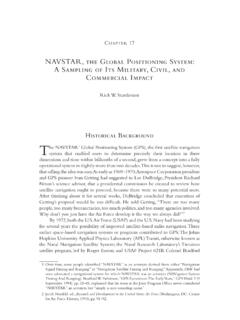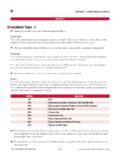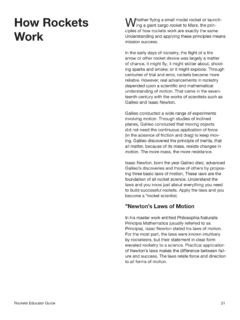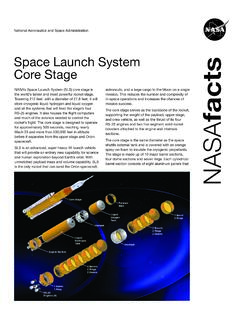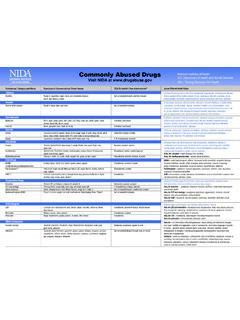Transcription of Space Resources - NASA
1 Space ResourcesMichael B. DukeColorado School of MinesTopics What are the Resources of Space ? Rationale for developing Space Resources Elements of a Space resource development program Economics of Space resource development Scale of early development is consistent with current capabilities of robotic spacecraft Levels of complexity Goals for next decade Exploration goals for Moon, Mars, Phobos/Deimos, asteroids Technologies PolicyWhat are the Resources of Relatively Near-Earth Space ? Energy Abundant sunlight (less with increasing distance from Earth) 3He (Moon, atmospheres of outer planets) Materials Water, oxygen (Lunar poles, Moon, Mars, carbonaceous asteroids) Inert gases (Mars, low concentrations on Moon) Metals, non-metals (Moon, Mars, stony asteroids) Real Estate Microgravity, access to vacuum, view of Earth Planetary surfaces Why Should We Develop Space Resources ? Humans won t spread far beyond Earth unless we develop the capability to utilize Space Resources for basic needs The cost of robotic and human activities in Space or on the surface of the Moon or Mars can be reduced by offsetting the need to bring propellants from Earth at high transportation costs New commercial opportunities can be opened in Space by providing alternative, lower cost sources of needed materials A prosperous Earth in the long term may require the development of the energy Resources of Space (while providing an enormous commercial opportunity)Longer Term Applications Other possible uses for Space Resources potentially offer significant returns New Earth orbital operations architectures Construction of solar power satellites or lunar power systems that beam energy to Earth Low-valued major constituents of asteroids (water, metals) for use in Space High-valued minor constituents of asteroids ( Pt, Pd, Ir)
2 For use on Earth 3He from the Moon for fusion energy Wide range of materials for Space industrialization (products manufactured in Space for use on Earth)Rationale for NASA Investment in Space Resources Reduce the cost and therefore increase the likelihood of undertaking NASA exploration missions (particularly human missions) Encourage the development of commercial activities in Space that can impact future U. S. economy Increase chances for technology synergies ( life support and propellant production systems may require similar separation technologies) Programmatic: Foster integrated program thrusts (Planetary Exploration, Microgravity Sciences, HEDS, Technology)NASA Mission Applications propellant production for return trips to Earth (can cut mass launched to LEO for Moon and Mars round trip missions by 1/2 3/4) significant reduction in cost of human missions Mars CH4/O2 Moon H2/O2from polar ice or lunar regolith Asteroids H2/O2from hydrated C-asteroids Life support consumables for humans (caches reduce risk for human missions)
3 Energy for human outposts Silicon solar cells made in-situ Construction associated with human outposts Radiation shielding Lunar and Mars outpost construction applicationsEarth-Orbital propellant Depots DARPA Orbital Express architecture conceived for military satellite servicing Primarily refueling of spacecraft whose orbits may change frequently Orbital propellant depots also would allow fueling of vehicles destined for HEO, Moon, Mars Commsats might become a commercial market with upper stage fuel provided in LEO (equatorial orbit?) Reusable orbital transfer vehicles would save additional Earth launch mass, reducing operational costs Similar propellant depot at L-1 for Moon and beyond Could these be supplied with lower cost propellant from Moon or asteroids?Low-Cost, High-Risk LaunchTarget OrbitFuel Holding OrbitFuel and Upgraded AvionicsTransfer OrbitAUTONOMOUS TRANSFER VEHICLEREFUELABLE/ UPGRADABLESPACECRAFTDOCKINGADAPTERSLow-C ost, High-Risk LaunchTarget OrbitFuel Holding OrbitFuel and Upgraded AvionicsTransfer OrbitAUTONOMOUS TRANSFER VEHICLEREFUELABLE/ UPGRADABLESPACECRAFTDOCKINGADAPTERSDARPA Orbital Express Architecture (with ETMA ugmentation)ETMR esupplySilicon Photovoltaic Cells on the Moon Solar energy is abundant on the Moon Silicon photovoltaic devices made of lunar materials might be deposited directly onto the lunar surface, avoiding cost of transporting structural materials Most of the components of the PV devices are naturally available on the Moon (Si, Al, SiO2)
4 A conceptual system has been defined to emplace silicon PV cells sequentially smooths, melts upper regolith surfaces, vacuum deposits PV cell components In principle, an Athena rover scale machine could emplace hundreds of kilowatts of power capability in a year Research is underway (fitfully) to learn how to produce PV-grade silicon on the MoonHuman Energy Use (D. Criswell) Average electrical power use in developed nations (300 million people) is ~ 2 kW/person; in the rest of the world, ~ ( billion people). Current world electricity production is ~ billion kW By 2050, there will be 10 billion people. If the standard of living of the whole world approached current western standards, 20 billion kW would be required. Two possibilities exist: Living standards will remain low for much of the world Additional sources of energy will be developed. Energy from Space could be inexhaustible, clean, and inexpensive (Solar Power Satellites, Lunar Power System)Lunar Power System (D.)
5 Criswell)PV arrays deposited directlyonto the lunar surfacePower collected in indivi-dual plots Wire mesh antennas transmit microwaves to Earth (a giant phased array,electronically steered, farfield optics) Crawler traverses Lunar surface, smoothing, melting a top layer of regolith, then depositingelements of silicon PV cells directly on surface Concept due to A. Ignatiev, U. of Houston (NIAC)Elements of a Space Resources Architecture Exploration and development of Resources Production of raw materials Extraction, refining to simple materials Manufacturing of more complex items Transportation ServicingEconomic Considerations For economic resource development, a need, or market must exist. Therefore, resource development can not be its own end Definition of the market establishes the amount of product and the price at which it must be delivered Near- to mid-term potential markets include propellant for Space science missions (Mars sample return) propellant in LEO (Orbital Express) propellant and energy for human lunar or Mars activities Long-term markets could include Energy to Earth (solar, 3He) Material support to lunar or Mars outposts Support of Space industrialization, Space tourismOther Considerations The farther (energetically) from Earth the product is used, the more competitive it will be - using propellant to return a spacecraft on Mars is economically easier than lunar oxygen to LEO) The more complex the Space production and manufacturing process, the more likely that a product will be brought from Earth for use in Space simple uses (like propellant )
6 Will be developed first Lower Earth-orbit and in- Space transportation costs diminish the competitiveness of Space resource applications, assuming that Space resource development and operations costs are fixed Cost/benefit Principal factors in determining cost of Space resource development Extraction, processing and manufacturing system development Transportation of processing equipment to Space Operations (including maintenance and repair) Cost of money (long development or delivery times undesirable) Benefits Transportation costs offset by availability of Space Resources New markets on Earth enabled by Space Resources Strategic benefits ( control of energy supplies) In determining cost/benefit, the utility, rather than simply the mass of the resource, must be compared Example: A device made from asteroidal iron in Space may not be as good as one made on Earth and shipped to Space Manufacturing costs must be included (simplest products are best) Space Resources vs. Earth Supply For economic viability, the cost of using Space Resources must be less than that of the same product (with the same performance) delivered from EarthLM-HCost of money (development and installation time)L-MM-HOperations costsHLTransportation L-MHDevelopment of productEarthISRUCost ElementEarly Small Scale Applications can be Evolutionary from Current Robotic Missions A small amount of machinery operating for a long period of time and with low energy inputs can produce a great amount of product, which otherwise would have to be transported from Earth drives autonomy/reliability/automated repair technologies Examples.
7 A Mars ISPP system with a mass of ~200 kg operating over 26 months could produces 10,000 kg of propellant that would otherwise have to be transported Lunar ice excavation models suggest that a 200 kg system could produce 4000 kg/yr of propellant Lunar silicon PV cell production estimates suggest a device with a mass of 200 kg could emplace 100 s of kilowatts of power in a year Production of useful quantities are consistent with capabilities of current small robotic spacecraft for the Moon and MarsTim Muff Rover SimComplexity is an issue Various processes have different levels of complexity Martian propellant for return trips to Earth Pump atmospheric CO2split to retain O2 and produce CH4 Lunar polar water for lunar return trips and Space propellant depot architectures Excavate cold trap regolith, thermally extract water, electrolyze and liquefy to produce propellant Photovoltaic cells produced from lunar materials Produce Si from lunar materials, recover reagents, manufacture arrays At the lower end of complexity, precedents are available in the Space program ( life support systems for ISS) At the higher end of complexity, new technology and operations approaches will be neededExample of Complexity: Processing Lunar Anorthite Lunar anorthite (CaAl2Si2O8) is very abundant It could be a source for elemental silicon (PV cells), aluminum (electrical conductors), Al2O3and CaO (cements, ceramics) and oxygen A process has been proposed by which anorthite is reduced to its oxide species.
8 CaAl2Si2O8 CaO + Al2O3+2 SiO2 Schematic of Anorthite Digestion ProcessDigest Anorthitewith H2SO4 Filter solutionSiO2 Precipitate sulfatesConvert to oxidesCaO, Al2O3 ReconstituteH2SO4SO3 Mine AnorthitePowerH2 OChallenges Excavation and material handling Staged chemical reactors for digestion, precipitation of dissolved solids, separation of liquids and solids, reactions between oxygen and solids Regeneration of reagents (full recovery desired) Reactor vessels (tanks), filters, stills, condensers, pumps, valves, storage reservoirs, etc. Energy and thermal engineering Implied surface transportation Energy systems providing thermal and electrical power System engineering and integrationGoals for the Next Decade Exploration missions Continue exploration to identify and characterize Resources Mars sample return; characterize distribution of water Lunar polar exploration Characterize and explore near-Earth asteroids Conduct ISRU demonstration experiments on Moon and Mars in conjunction with scientific exploration missions Technology development Demonstrate feasible techniques for producing energy and propellant based on Space Resources focus on robotic systems Long-lived, robust, systems requiring little or no maintenance Government Policy Create an environment in which commercial development of Space Resources can begin Provide guaranteed markets for Resources from Space Provide incentives within exploration programs for Space resource iliiSummer, noontimeimage.
9 Shadowedareas are mostlyin permanent Prospectorneutron spectro-meter has detectedenrichments of hydrogen in thepolar regions,consistent with cold-trapped iceClementine Image of Lunar North PoleLunar Polar Exploration Determine nature and distribution of hydrogen enrichments near lunar poles History of cometary impacts (stratigraphy) Airless planet surface phenomena Form of hydrogen (vis a vis thermal extraction) Distribution of hydrogen in upper few meters of lunar surface Demonstrate operations in permanent shadow Demonstrate extraction of hydrogen/water and production of propellants Can be carried out using robotic landers of same complexity no greater than Mars Athena roverMartian Resource Exploration Atmosphere is well enough known for resource purposes Location of metal and non-metal concentrations will require detailed in-situ exploration at an appropriate time Water is the nearest-term, most valuable resource Possibility of extraction from regolith clay minerals Permafrost Subterranean liquid water or brines Regolith and permafrost are possible near term sources TEGA like instruments for water characterization Geophysical sounding to detect permafrost Drilling technology eventually to tap liquid water, if it exists Resource exploration investigations and demonstrations should be included in robotic science missions ( MIP)
10 Asteroid Resource Exploration Increasing discovery rate for near Earth asteroids Need to upgrade spectroscopic characterization capabilities to better identify asteroid chemical types Sample return missions to selected asteroids are required before economic recovery can be planned Nature of asteroid regolith Availability of Resources Phobos & Deimos should be studied in a similar mannerNew Technology is Needed A technology program is essential Many techniques are complex, but not beyond the state of current technology for electrical and mechanical elements (equivalent to advanced life support systems) Efforts to reduce the scale are important in translating terrestrial practice to the Space environment Durable mechanical systems with long times between failure in difficult environments will be essentialTechnology Development HTCI has developed aggressive roadmaps for Space Resources technology development In-Situ Resource Assessment, Extraction, & Separation Resource Processing & Refining In-Situ Manufacturing Surface Construction Surface Cryogenic and Product Storage & Distribution Space Resource Development should continue to be supported strongly within HTCI Systems and technology development aimed at long duration operations; and effectiveness in small scale systems Supporting technologies, such as power, surface transportation, automation and robotics, etc.
